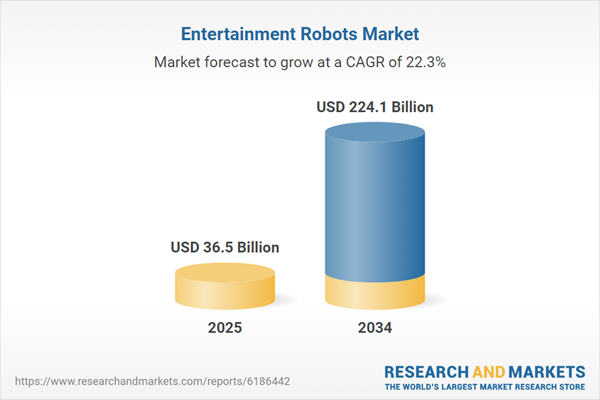Market Overview: Entertainment Robots Market
The entertainment robots market has emerged as a dynamic segment within the robotics industry, fueled by the increasing demand for interactive, personalized, and engaging experiences. These robots, designed for leisure, amusement, and entertainment purposes, are being increasingly integrated into various sectors, including theme parks, consumer electronics, retail, and hospitality. Entertainment robots serve a wide range of functions, from providing companionship and performing tasks to engaging audiences with interactive performances and content. As technological advancements in AI, machine learning, and robotics continue to evolve, these robots are becoming more intelligent, responsive, and capable of offering a more immersive user experience. The growing fascination with robotics, particularly among younger generations, along with the influence of social media and entertainment trends, has significantly expanded the market. Furthermore, the integration of robots into live shows, exhibitions, and events is creating a new frontier for interactive and digital entertainment. This growth is supported by the convergence of entertainment and technology, opening new possibilities for both business applications and consumer experiences.The entertainment robots market witnessed significant advancements, particularly driven by the rapid development of humanoid robots and AI-powered robots designed for entertainment purposes. Major players in the market focused on creating robots capable of interacting with users in more personalized ways, using voice recognition, facial expressions, and gestures. The demand for companion robots also surged, as people increasingly sought out robots for companionship, especially in light of growing social isolation and the need for interactive engagement. Additionally, robots in theme parks and shopping malls were enhanced with more sophisticated programming to deliver performances and personalized experiences. Collaborations between robotics companies and media outlets allowed for the development of branded entertainment robots, leveraging the popularity of animated characters and celebrities. The rise of robotic pets, such as AI-driven robotic dogs, also gained popularity, providing a new form of entertainment and companionship for pet lovers. These developments, coupled with decreasing manufacturing costs, made entertainment robots more accessible to a broader range of consumers.
The entertainment robots market is set to experience continued growth, driven by technological innovations and expanding applications. Robotics manufacturers are expected to push the boundaries of what robots can achieve in terms of emotion recognition, creativity, and human-like interactions. Advances in AI and natural language processing will enable robots to engage in more sophisticated conversations, making them even more lifelike and capable of building deeper connections with users. The integration of augmented reality (AR) and virtual reality (VR) into entertainment robots will create opportunities for immersive, multi-sensory experiences that blur the lines between physical and digital entertainment. As consumers increasingly demand highly interactive and personalized entertainment experiences, robots will evolve from simple entertainers to versatile, interactive companions that can perform a variety of roles in gaming, education, and live performances. Moreover, with the increasing focus on sustainability, the use of eco-friendly materials in robot design and energy-efficient technologies will become a key trend. The market will also see more robots entering the home entertainment space, further enhancing their role as personal companions and home assistants.
Key Insights: Entertainment Robots Market
- AI-Powered Personalization: The use of artificial intelligence in entertainment robots is enabling more personalized interactions. These robots can analyze user preferences and behaviors to tailor their performances, conversations, and interactions, creating highly customized entertainment experiences that resonate with individual users.
- Robotic Companions and Pets: The increasing demand for robotic pets is a significant trend in the market. These robots provide companionship and emotional support, particularly for people who are unable to have real pets, or those who seek an interactive, low-maintenance alternative to traditional pets.
- Integration of Augmented and Virtual Reality: Entertainment robots are increasingly being integrated with AR and VR technologies, offering immersive and multi-sensory experiences. This trend is reshaping the entertainment landscape, allowing robots to engage with users in new and exciting ways, such as virtual performances or interactive gaming experiences.
- Humanoid Robots for Live Performances: Humanoid robots designed for live performances and events are gaining popularity. These robots can mimic human movements and emotions, performing in music shows, theatrical performances, and theme park attractions, providing audiences with unique and interactive entertainment experiences.
- Affordable Consumer Robots: As manufacturing costs decrease, entertainment robots are becoming more affordable for consumers. This trend is opening up the market to a wider range of buyers, enabling the integration of robots into home entertainment systems and personal companionship applications.
- Increasing Consumer Interest in Robotics and AI: The growing fascination with robotics and AI, particularly among younger generations, is driving demand for entertainment robots. People are increasingly looking for interactive and innovative ways to engage with technology in their personal lives, boosting market growth.
- Technological Advancements in AI and Robotics: Continuous improvements in AI and robotics are making entertainment robots more capable, responsive, and lifelike. These advancements are enabling robots to perform more complex tasks, engage in natural conversations, and offer highly personalized experiences to users.
- Expanding Applications in Theme Parks and Retail: Entertainment robots are being increasingly integrated into theme parks, shopping malls, and retail environments. Robots are used to deliver performances, interact with visitors, and provide personalized experiences, creating new business opportunities for companies in the entertainment and retail sectors.
- Social Isolation and the Need for Companionship: The rising demand for robotic companions, especially in light of increasing social isolation and loneliness, is a key driver for the market. Entertainment robots provide emotional support and interactive companionship, which is becoming increasingly valuable in modern society.
- High Development and Manufacturing Costs: The development and manufacturing of entertainment robots involve significant costs due to the complexity of their design, the integration of advanced AI, and the need for high-quality materials. These high costs can make robots inaccessible to a broader consumer base and limit market growth in the short term.
Entertainment Robots Market Segmentation
By Product
- Robot Toys
- Educational Robots
- Robotic Companion Pets
By Component
- Software
- Hardware
By End-User
- Media
- Education
- Retail
- Other End Users
Key Companies Analysed
- KUKA AG
- Hasbro Inc.
- Modular Robotics Inc.
- Mattel Inc.
- Sphero Inc.
- Blue Frog Robotics
- Robobuilder Co Ltd.
- Sony Corporation
- LEGO System A/S
- Hanson Robotics Limited
- SoftBank Robotics Group
- Anybots Inc.
- Abyss Creation LLC
- WowWee Group Limited
- UBTECH Robotics Corp Ltd.
- Boston Dynamics Inc.
- ABB Group.
- FANUC Robotics America Corporation
- Yaskawa Electric Corporation
- Omron Adept Technologies
- Epson America Inc.
- Kawasaki Robotics Ltd.
- Universal Robots A/s
- Rethink Robotics Inc.
- GreyOrange Pte. Ltd.
- Fetch Robotics Inc.
- Locus Robotics Corporation
- IAM Robotics
- Brain Corp
- Savioke Inc.
- Knightscope Inc.
- Simbe Robotics Inc.
Entertainment Robots Market Analytics
The report employs rigorous tools, including Porter’s Five Forces, value chain mapping, and scenario-based modeling, to assess supply-demand dynamics. Cross-sector influences from parent, derived, and substitute markets are evaluated to identify risks and opportunities. Trade and pricing analytics provide an up-to-date view of international flows, including leading exporters, importers, and regional price trends.Macroeconomic indicators, policy frameworks such as carbon pricing and energy security strategies, and evolving consumer behavior are considered in forecasting scenarios. Recent deal flows, partnerships, and technology innovations are incorporated to assess their impact on future market performance.
Entertainment Robots Market Competitive Intelligence
The competitive landscape is mapped through proprietary frameworks, profiling leading companies with details on business models, product portfolios, financial performance, and strategic initiatives. Key developments such as mergers & acquisitions, technology collaborations, investment inflows, and regional expansions are analyzed for their competitive impact. The report also identifies emerging players and innovative startups contributing to market disruption.Regional insights highlight the most promising investment destinations, regulatory landscapes, and evolving partnerships across energy and industrial corridors.
Countries Covered
- North America - Entertainment Robots market data and outlook to 2034
- United States
- Canada
- Mexico
- Europe - Entertainment Robots market data and outlook to 2034
- Germany
- United Kingdom
- France
- Italy
- Spain
- BeNeLux
- Russia
- Sweden
- Asia-Pacific - Entertainment Robots market data and outlook to 2034
- China
- Japan
- India
- South Korea
- Australia
- Indonesia
- Malaysia
- Vietnam
- Middle East and Africa - Entertainment Robots market data and outlook to 2034
- Saudi Arabia
- South Africa
- Iran
- UAE
- Egypt
- South and Central America - Entertainment Robots market data and outlook to 2034
- Brazil
- Argentina
- Chile
- Peru
Research Methodology
This study combines primary inputs from industry experts across the Entertainment Robots value chain with secondary data from associations, government publications, trade databases, and company disclosures. Proprietary modeling techniques, including data triangulation, statistical correlation, and scenario planning, are applied to deliver reliable market sizing and forecasting.Key Questions Addressed
- What is the current and forecast market size of the Entertainment Robots industry at global, regional, and country levels?
- Which types, applications, and technologies present the highest growth potential?
- How are supply chains adapting to geopolitical and economic shocks?
- What role do policy frameworks, trade flows, and sustainability targets play in shaping demand?
- Who are the leading players, and how are their strategies evolving in the face of global uncertainty?
- Which regional “hotspots” and customer segments will outpace the market, and what go-to-market and partnership models best support entry and expansion?
- Where are the most investable opportunities - across technology roadmaps, sustainability-linked innovation, and M&A - and what is the best segment to invest over the next 3-5 years?
Your Key Takeaways from the Entertainment Robots Market Report
- Global Entertainment Robots market size and growth projections (CAGR), 2024-2034
- Impact of Russia-Ukraine, Israel-Palestine, and Hamas conflicts on Entertainment Robots trade, costs, and supply chains
- Entertainment Robots market size, share, and outlook across 5 regions and 27 countries, 2023-2034
- Entertainment Robots market size, CAGR, and market share of key products, applications, and end-user verticals, 2023-2034
- Short- and long-term Entertainment Robots market trends, drivers, restraints, and opportunities
- Porter’s Five Forces analysis, technological developments, and Entertainment Robots supply chain analysis
- Entertainment Robots trade analysis, Entertainment Robots market price analysis, and Entertainment Robots supply/demand dynamics
- Profiles of 5 leading companies - overview, key strategies, financials, and products
- Latest Entertainment Robots market news and developments
Additional Support
With the purchase of this report, you will receive:- An updated PDF report and an MS Excel data workbook containing all market tables and figures for easy analysis.
- 7-day post-sale analyst support for clarifications and in-scope supplementary data, ensuring the deliverable aligns precisely with your requirements.
- Complimentary report update to incorporate the latest available data and the impact of recent market developments.
This product will be delivered within 1-3 business days.
Table of Contents
Companies Mentioned
- KUKA AG
- Hasbro Inc.
- Modular Robotics Inc.
- Mattel Inc.
- Sphero Inc.
- Blue Frog Robotics
- Robobuilder Co Ltd.
- Sony Corporation
- LEGO System A/S
- Hanson Robotics Limited
- SoftBank Robotics Group
- Anybots Inc.
- Abyss Creation LLC
- WowWee Group Limited
- UBTECH Robotics Corp Ltd.
- Boston Dynamics Inc.
- ABB Group.
- FANUC Robotics America Corporation
- Yaskawa Electric Corporation
- Omron Adept Technologies
- Epson America Inc.
- Kawasaki Robotics Ltd.
- Universal Robots A/s
- Rethink Robotics Inc.
- GreyOrange Pte. Ltd.
- Fetch Robotics Inc.
- Locus Robotics Corporation
- IAM Robotics
- Brain Corp
- Savioke Inc.
- Knightscope Inc.
- Simbe Robotics Inc.
Table Information
| Report Attribute | Details |
|---|---|
| No. of Pages | 160 |
| Published | October 2025 |
| Forecast Period | 2025 - 2034 |
| Estimated Market Value ( USD | $ 36.5 Billion |
| Forecasted Market Value ( USD | $ 224.1 Billion |
| Compound Annual Growth Rate | 22.3% |
| Regions Covered | Global |
| No. of Companies Mentioned | 32 |









